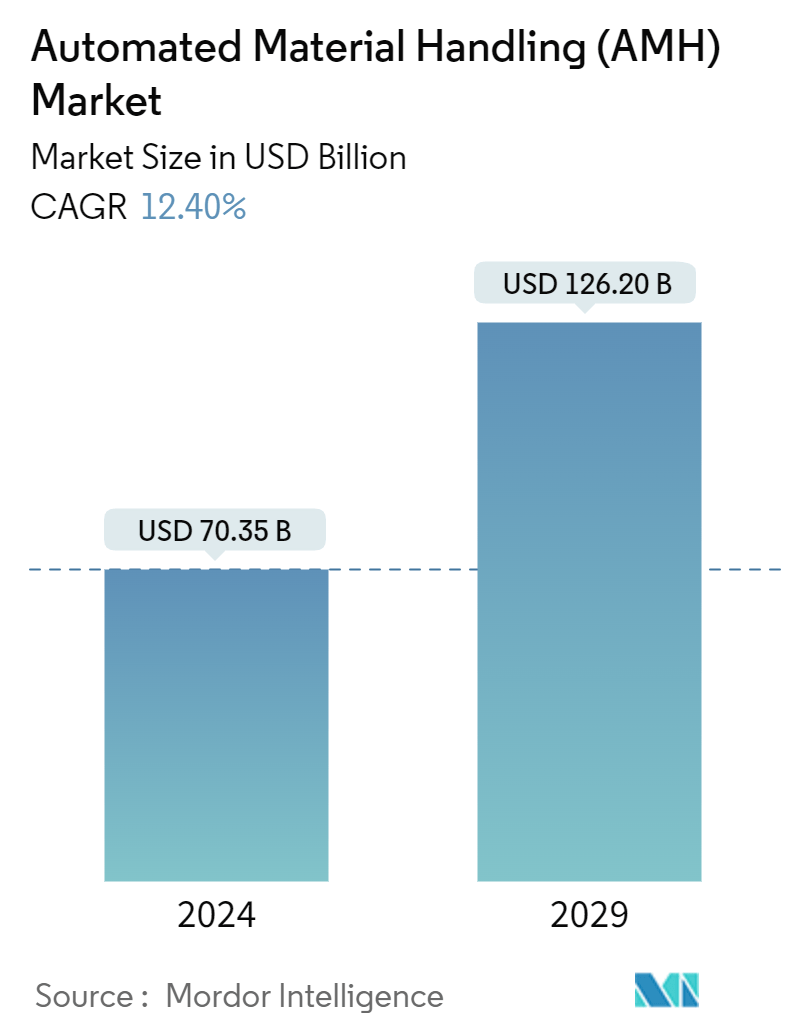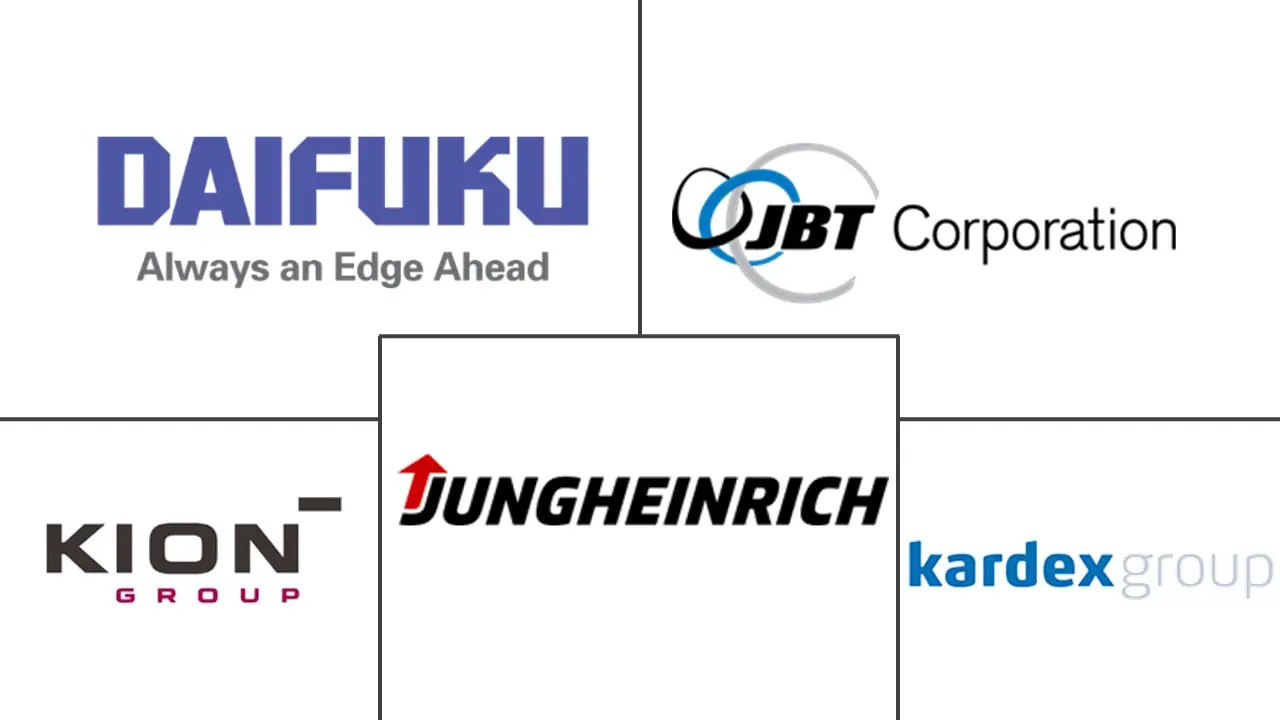Market Size of Automated Material Handling (AMH) Industry

| Study Period | 2019 - 2029 |
| Market Size (2024) | USD 70.35 Billion |
| Market Size (2029) | USD 126.20 Billion |
| CAGR (2024 - 2029) | 12.40 % |
| Fastest Growing Market | Asia-Pacific |
| Largest Market | North America |
Major Players
*Disclaimer: Major Players sorted in no particular order |
Automated Material Handling (AMH) Market Analysis
The Automated Material Handling Market size is estimated at USD 70.35 billion in 2024, and is expected to reach USD 126.20 billion by 2029, growing at a CAGR of 12.40% during the forecast period (2024-2029).
- Technological advancements, rising labor costs and safety concerns, improved efficiency in manufacturing and warehouse operations, a significant recovery in global manufacturing, increasing demand for automation in industries, growing need for robots in manufacturing units and warehousing facilities, and the growth of emerging markets are key factors driving the automated material handling market. Additionally, the market will benefit from the expanding digitization of supply chain operations, further supported by increasing order customization and personalization during the forecast period.
- Automated Material Handling (AMH) systems streamline the movement of materials across various settings, including manufacturing facilities, warehouses, retail outlets, airports, and logistics centers. These systems facilitate the seamless transfer of materials, whether within the same area, across departments, or even between distinct buildings. AMH systems rely on routes designated by the manufacturing execution system (MES). These systems employ various technologies, including optical character recognition (OCR), barcodes, RFID, ultra-wideband indoor tracking, and near-field communication.
- Over the past seven decades, material handling has undergone significant transformations, reshaping the industry's landscape. Machines and robots have largely supplanted manual labor, catalyzing growth across sectors. Notably, the automotive industry stands out, boasting a remarkable tenfold expansion. Canada's advancements in Industry 4.0 and cutting-edge manufacturing are revolutionizing product design, delivery, and maintenance, even in diverse climates. From robotics and automation to additive manufacturing (3D printing), these technologies find broad utility in sectors spanning e-commerce, automotive, agriculture, and pharmaceuticals. Canadian innovators are spearheading the creation of sophisticated, high-value products, not only for domestic markets but also for a fiercely competitive global arena. Their initiatives not only elevate local practices but also set the stage for collaborative ventures that will define the trajectory of advanced automation technologies.
- While the first AGV debuted in 1953, widespread adoption across production and warehousing firms has been hindered by various factors, with cost being a primary concern. A typical guided vehicle is priced between USD 60,000 and 100,000, but systems with advanced features like navigation aids and sensors can be considerably pricier. These high upfront costs, coupled with maintenance challenges, are dampening the market's growth. Leading firms are striving to control costs without compromising on innovation or R&D investments.
- The COVID-19 pandemic has significantly impacted the adoption of automation across sectors, reshaping operational norms and introducing challenges such as social distancing and contactless operations. Organizations faced surging demands and reduced workforces, prompting the implementation of enhanced safety protocols. Since 2020, the outbreak affected the US workers, compelling companies to adopt new safety measures swiftly. While some industries, like food production, experienced shutdowns due to the virus's severity, many others adapted by incorporating stringent health measures to sustain operations.
Automated Material Handling (AMH) Industry Segmentation
Automated material handling systems employ computerized devices and robots to handle tasks such as moving, lifting, storing, and retrieving products, replacing traditional human labor. The scope of the study focuses on the market analysis is segmented by product type (hardware, software, and services), equipment type (mobile robots (automated guided vehicle (AGV) and autonomous mobile robot(AMR)), automated storage and retrieval system (fixed aisle, carousel, and vertical lift module), automated conveyor (belt, roller, pallet, and overhead), palletizer (conventional and robotic), and sortation system), end user (airport, automotive, food and beverages, retail/warehousing/distribution centers/logistic centers, general manufacturing, pharmaceuticals, post and parcel, and other end users), and Geography (North America, Europe, Asia-Pacific, Latin America, and Middle East and Africa). The market sizes and forecasts are provided in terms of value (USD) for all the above segments.
| By Product Type | |
| Hardware | |
| Software | |
| Services |
| By Equipment Type | ||||||
| ||||||
| ||||||
| ||||||
| ||||||
| Sortation System |
| By End User | |
| Airport | |
| Automotive | |
| Food And Beverages | |
| Retail/Warehousing/Distribution Centers/Logistic Centers | |
| General Manufacturing | |
| Pharmaceuticals | |
| Post and Parcel | |
| Other End Users |
| By Geography*** | ||||||
| ||||||
| ||||||
| ||||||
| Australia and New Zealand | ||||||
| ||||||
|
Automated Material Handling (AMH) Market Size Summary
The automated material handling (AMH) market is poised for significant growth, driven by technological advancements and the increasing demand for automation across various industries. Key factors such as rising labor costs, safety concerns, and the need for improved efficiency in manufacturing and warehouse operations are propelling the market forward. The market is also benefiting from the recovery in global manufacturing and the expansion of emerging markets. The digitization of supply chain operations, along with the growing need for robots in manufacturing units and warehousing facilities, is further supporting this growth. AMH systems, which streamline the movement of materials across diverse settings, are becoming increasingly prevalent, leveraging technologies like optical character recognition, barcodes, RFID, and near-field communication to enhance operational efficiency.
The market landscape is characterized by semi-consolidation and high competitiveness, with key players focusing on product innovation, strategic partnerships, and significant investments in research and development to maintain their competitive edge. The COVID-19 pandemic has accelerated the adoption of automation, as companies sought to implement contactless operations and enhance safety protocols. Countries like China, Germany, and India are making substantial strides towards Industry 4.0, with initiatives aimed at boosting manufacturing output and embracing smart manufacturing practices. The market is also witnessing strategic collaborations and acquisitions, such as KION North America's partnership with Fox Robotics and Coesia's acquisition of Automation & Modular Components, which are expected to drive further growth and innovation in the AMH sector.
Automated Material Handling (AMH) Market Size - Table of Contents
-
1. MARKET INSIGHTS
-
1.1 Market Overview
-
1.2 Industry Value Chain Analysis
-
1.3 Industry Attractiveness - Porter's Five Forces Analysis
-
1.3.1 Bargaining Power of Suppliers
-
1.3.2 Bargaining Power of Consumers
-
1.3.3 Threat of New Entrants
-
1.3.4 Intensity of Competitive Rivalry
-
1.3.5 Threat of Substitute Products
-
-
1.4 Impact of the COVID-19 Pandemic on the Market
-
-
2. MARKET SEGMENTATION
-
2.1 By Product Type
-
2.1.1 Hardware
-
2.1.2 Software
-
2.1.3 Services
-
-
2.2 By Equipment Type
-
2.2.1 Mobile Robots
-
2.2.1.1 Automated Guided Vehicle (AGV)
-
2.2.1.2 Autonomous Mobile Robot (AMR)
-
-
2.2.2 Automated Storage and Retrieval System
-
2.2.2.1 Fixed Aisle
-
2.2.2.2 Carousel
-
2.2.2.3 Vertical Lift Module
-
-
2.2.3 Automated Conveyor
-
2.2.3.1 Belt
-
2.2.3.2 Roller
-
2.2.3.3 Pallet
-
2.2.3.4 Overhead
-
-
2.2.4 Palletizer
-
2.2.4.1 Conventional
-
2.2.4.2 Robotic
-
-
2.2.5 Sortation System
-
-
2.3 By End User
-
2.3.1 Airport
-
2.3.2 Automotive
-
2.3.3 Food And Beverages
-
2.3.4 Retail/Warehousing/Distribution Centers/Logistic Centers
-
2.3.5 General Manufacturing
-
2.3.6 Pharmaceuticals
-
2.3.7 Post and Parcel
-
2.3.8 Other End Users
-
-
2.4 By Geography***
-
2.4.1 North America
-
2.4.1.1 United States
-
2.4.1.2 Canada
-
-
2.4.2 Europe
-
2.4.2.1 Germany
-
2.4.2.2 France
-
2.4.2.3 Italy
-
2.4.2.4 Spain
-
-
2.4.3 Asia
-
2.4.3.1 China
-
2.4.3.2 Japan
-
2.4.3.3 India
-
-
2.4.4 Australia and New Zealand
-
2.4.5 Latin America
-
2.4.5.1 Brazil
-
2.4.5.2 Mexico
-
-
2.4.6 Middle East and Africa
-
2.4.6.1 United Arab Emirates
-
2.4.6.2 Saudi Arabia
-
2.4.6.3 South Africa
-
-
-
Automated Material Handling (AMH) Market Size FAQs
How big is the Automated Material Handling Market?
The Automated Material Handling Market size is expected to reach USD 70.35 billion in 2024 and grow at a CAGR of 12.40% to reach USD 126.20 billion by 2029.
What is the current Automated Material Handling Market size?
In 2024, the Automated Material Handling Market size is expected to reach USD 70.35 billion.

